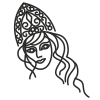WikiUral 2016


WikiUral Competition is a global Wiki contest dedicated to Ural. The purpose of the contest is creation and improvement of articles that correspond to Wikipedia notability guidelines. We invite you to enrich Wikipedia with quality works about the Earth's nature phenomenon—Ural mountains, history of its discovery, exploration, economy and culture of the Ural region and other aspects of Uralic life.
The contest is dedicated to the memory of Lev Vladimirovich Ban'kovsky, scientist and encyclopedist who lived in Ural region and worked for long time at Ural branch of Russian Academy of Sciences. During preparations for the contest many of the materials (classifiers, glossaries, dictionaries and encyclopaedias) were used which also were used by Bankovsky when he was working on Ural Encyclopaedia, Upper Kama Encyclopaedia and other works.
The 2nd round of the WikiUral Competition is being held from December 15, 2016 until July 1, 2017 (inclusively). The 1st round has ended on December 15, 2016. Articles that were created during the 1st round in the projects/editions of Wikipedia where the Competition was not announced completed, automatically go to the 2nd Round.
All of the participants in those Wikipedia editions, where the Competition was announced completed, can also participate in the 2nd round, but no more material prizes are planned there (this may be changed in the future though).
This is the English language page of the contest (Meta-Wiki version, see also WMRU version).
The definition of Ural is:
Ural (russian: Урал) — geographical region located in Russia and Kazakhstan, also Ural economic region and administrative division of Ural Federal District.
What Ural is famous for?
[edit]
Stockpot of natural resources. It is an unique mountainous area and a stockpot of natural resources. According to scientists, this mountainous system emerged in the early Paleozoic Age. The stone belt appeared when the Western-Siberian Platform overthrust the Russian Plain. The remains of formerly huge volcanic mass suggest that half a billion years ago, magma was erupting here. Local geology formed thick oil-bearing strata and other mineral deposits.[1].

Shikhan-type mountains (Russian: шиханы). Researchers find a remarkable difference between the slope structures of Ural Mountains: for several geological periods, the sea had been washing western slopes and, thus, it left up to several kilometers thick layer of sediments. By the end of the Carboniferous age, the sea had retreated. However, Bashkir shikhans, ancient sea reefs, are still there to remind us about these ancient times. The Ural Mountains continue growing slowly but steadily.[1]

Perm geological system. The Discovery of Perm geological system began with the academic expeditions of P. Pallas, P. and N. Richkov in the 18th century. An English geologist R. Murchison was the leader of another expedition, worked in the Urals in 1841. As the result of this work there was the global discovery—the discovery of Perm geological system. The main arguments in favor of Murchison's idea were the enormous fossils (more than 188 kinds), that had been found in the Urals and in the north of the European Russia. In the 1950th and 60th years the first Soviet mechanized paleontological excavations were made, headed by P. Chudinov in the village Ezhovo near Ochor. The results were incredible. Ten unknown kinds of fossil animals were found.[2]


Country of Towns. As early as 3,600—3,800 years ago, the South Urals have been a home of an unique civilization of over two dozen of cities. It was named a proto-city civilization, Russia's oldest Country of Cities. Its citizens knew metal production technology and could easily process granite, quartz and other rather hard rocks.[1]
Mining industry ("Gornozavodskaya") "civilization". In the 18—19th centuries, successful surveys of various natural resources gave birth to a new Ural "civilization", now used to be called "mining civilization" ("Gornozavodskaya"). Ethnographer and literature theorist Prof. Bogoslovsky proved its existence. From the early 18th to the middle of 19th century, 260 industrial cities have been built in the Urals, i.e. more than half of the cities built in the rest of Russia within the same period. These cities had a distinct purpose and specific style of artistic design. In the first quarter of the 19th century, industrial cities grew big enough to have ensemble architecture, a governorate (regional) architect, and architects of mining factories and areas. A significant part of the Ural culture, these cities are essential from the viewpoint of global science, technology and art. In the 18th century, industrial cities made the Urals not only the area of largest industrial construction, but also the world's largest metallurgy center.[1]

Ural equipment. Many different Urals machines influenced not only domestic, but the whole world's engineering industry. For example, among the products of the Ural manufacturing plants is a giant walking shovel (dragline excavator) ESH-100.100 (boom length of 100 meters, and bucket capacity of 100 cubic meters). The journalists gave this machine a name "an exclamation mark of the domestic excavating machines construction process".[3]
Organizers
[edit]Wiki partners
[edit]General rules
[edit]- The contest takes into consideration the articles which are created and/or improved during the period: from 00:00:00 15 December 2016 until 23:59:59 (UTC) 01 July 2017 in the applicable projects of Wikipedia. The links to the articles are due to be placed at the dedicated page which is stated below. Incubators of Wikimedia are not applicable. The contest is held in those of existing projects of Wikipedia where language juries are approved, and local conditions for the holding of contest are accepted by the community and the organizers. The statuses of the contests in the corresponding projects will be displayed at this page in the special section.
- The articles have to be completed in the way when they are not subject to deletion and to urgent improvement. The articles should correspond to the Wikipedia Verifiability guidelines: any information that can be compromised should be confirmed using reliable sources. The articles should meet Wikipedia Notability guidelines. The articles should not contain multiple spelling, punctuation and stylistic errors. No "ranting" is allowed — articles should not contain "words that lack precision". If a participant creates large number of low quality articles, he/she receives a warning from the jury. If he/she persists, participant can be disqualified. Copyright violations are not permitted, violators may be punished according to Wikipedia copyright policies and disqualified. No machine-translation-like language should be used, the literature in references is recommended to be in the language of the corresponding Wikimedia project.
- Every participant should personally enter links to participating articles within the general multi-language WikiUral template.
- Every participating article should be included in this template only one time (exceptions can be made for the articles that are completely rewritten by another user after deletion or speedy deletion procedures).
- Contacts. Participants are encouraged to provide their e-mail addresses to the organizers. All of the participants are urged to register their e-mails in the Wikimedia project user settings.
- Awards also exist for the WLM and WLE sectors.
Guidelines for Wikimedia Commons (WLM and WLE)
[edit] WLM NOMINATION: The best photograph of Ural region from Wiki Loves Monuments 2016. 3 places and prizes.
WLM NOMINATION: The best photograph of Ural region from Wiki Loves Monuments 2016. 3 places and prizes.
 WLE NOMINATION: The best photograph of Ural region from Wiki Loves Earth 2016. 3 places and prizes.
WLE NOMINATION: The best photograph of Ural region from Wiki Loves Earth 2016. 3 places and prizes.
Rules for 37 Wikipedias
[edit]Contest for 37 Wikipedias:
- for projects in official U. N. languages: English, Arabic, Spanish, Chinese, Russian, French
- for projects in 27 languages of the peoples of Russia (according to main page of Wikimedia RU website), including Russian Wikipedia
- German Wikipedia
- Kazakh Wikipedia
- Japanese Wikipedia
- Hindi Wikipedia
- Portuguese Wikipedia
Prizes by nomination:
- General nomination: Overviewing articles about Ural region (by glossaries and other sources): conceptions, base terms, history, culture, geography etc. For each article (or expansion of an existing article in 2 times and more), that corresponds to abovementioned guidelines, a participant receives 1 point (size of the substantial part of the article should be not less than 5 kilobytes and correspond to "stub" criteria). Jury may mark the quality of improvement of an article by 1 or 2 additional points. Thus, maximum number of points for each article, that a participant can receive, equals to 3. Three prizes are assigned for each of the mentioned Wikipedias. Additional themes may be proposed, that aren't included in glossaries, but they must be approved by jury.
- Economics nomination: Overviewing articles about Ural region (by glossaries and other sources): economy. Three prizes are assigned for each of the mentioned Wikipedias.
- People nomination: Overviewing articles about Ural region (by glossaries and other sources): people. Three prizes are assigned for each of the mentioned Wikipedias.
Prizes for 37 Wikipedias
[edit]Certificate for the 3rd place. For the 1st place and 2nd place. More...
Rules for 257 Wikipedias
[edit]Contest for the existing language editions of Wikipedia, aside from 37 Wikipedias stated above. Without separate nominations.
Prizes for 257 Wikipedias
[edit]Two top places (prize and electronic certificate) for each of listed Wikipedias. Certificate for 3rd place. For 1st place there are two options. More...
Glossaries
[edit]Glossaries may be used for facilitation of the search for the article creation topics. A list of terms can be found e. g. at:
To participants
[edit]After creation or improvement of an article, it has to be included in the following table (participants must insert links by themselves at the multi-language WikiUral template for the 1st round Competition). Only items included in the template (articles, photos, etc.) can participate in the contest.
Notes
[edit]NB 1: For all participants: respect your colleagues, obey fair play principles. In particular, try to declare your participation in the contest as soon as possible. "Surprises" within the last days/hours/minutes of the contest in the form of many suddenly inserted articles (especially from those who weren't there previously) only look to be impressive, but in fact they don't: they only produce tension and irritation. Do not try to "stake out" many unwritten articles, work consistently. "Stubs" that are empty or very short (including those bearing templates such as "In use"), when the authors seem to "switch" to other articles, will be removed by jury soon.
NB 2: For newcomers: Jury members pledge to help you to add articles to the table, administrators or other experienced users also may (but not are obliged) to provide such help. You should ask them explicitly (by any open or closed means of communication). Articles written during the contest, but inserted into table after its end, are not accepted.
Jury
[edit]Juries may vary by language edition and project and their nicknames are published in corresponding local pages. Experts may be involved: such as employees of other organizations and experienced Wikipedians.
Conditions for prize delivery
[edit]The delivery of prizes by mail is possible if a "physical" mailing address of a winner is provided. The information should be sent to organizers nikolai.litvinov![]() wikimedia.ru not later than in 1 month after winners are announced.
wikimedia.ru not later than in 1 month after winners are announced.
Examples of rules
[edit]Award Ceremony
[edit]The Award Ceremony is expected to be held in Ekaterinburg city. Details pending.
In the press
[edit]- WikiUral press release for WikiUral Press Release
- Press about WikiUral contest (in Russian)
Links
[edit]- Official English website of WikiUral Competition on Wikimedia RU
- Official Russian website of WikiUral Competition on Wikimedia RU
- Official Bashkir website of WikiUral Competition on Wikimedia RU
- Official Russian website of Wikimedia RU, the coorganizer of WikiUral Competition
- Official English website of UMMC Holding — the coorganizer of WikiUral Competition
- Official English website of Moiseikin Jewelry House — the coorganizer of WikiUral Competition
- Official Russian website of VEK group of companies − the Sponsor of WikiUral Competition
Tools
[edit]- Le Loy's Fountain modern flexible tool for contests, edit-a-thons, ect.
- About Le Loy's Fountain tool
References
[edit]- ↑ a b c d Башкортостан. Слияние Европы и Азии. (Bashkortostan. At the Junction of Europe and Asia.) — Уфа: Издательский дом «Башкирская Пресса» (совместно с Правительством Республики Башкортостан), 2015 — С.32-33. (ШОС-БРИКС Уфа 2015).
- ↑ Л. Баньковский, П. Софроницкий. Л. Перескоков (англ. текст) Пермская система. (Perm geological system.) — Пермь: Пермский областной совет всероссийского общества охраны природы, Пермский областной комитет охраны природы, 1991. Международный геологический конгресс «Пермская система земного шара 1991» (Permian system of the world Congress 1991).
- ↑ Уралмашзавод в фактах. Фотоальбом. (Uralmash-UZTM Photoalbum.) — Екатеринбург: издательство ООО «Аристократ», 2013. — 144 с. — ISBN 978-5-7688-1088-7. — 1000 экз.





